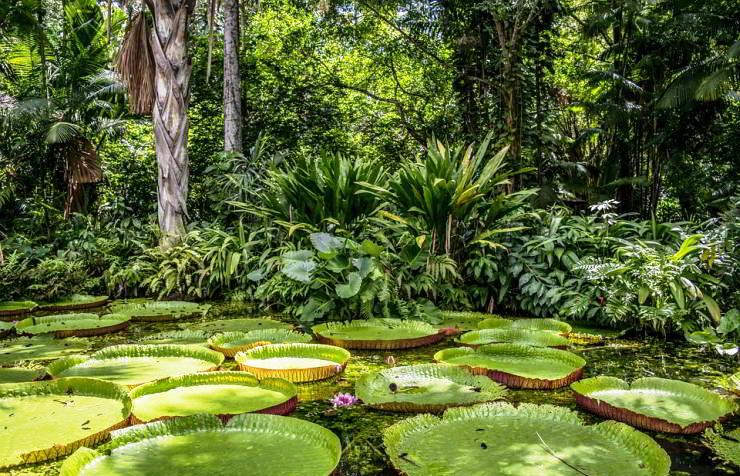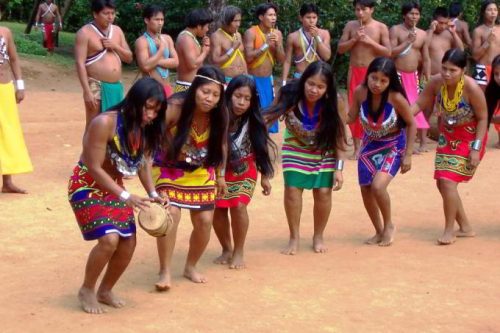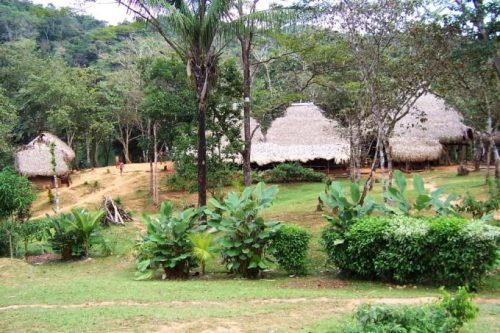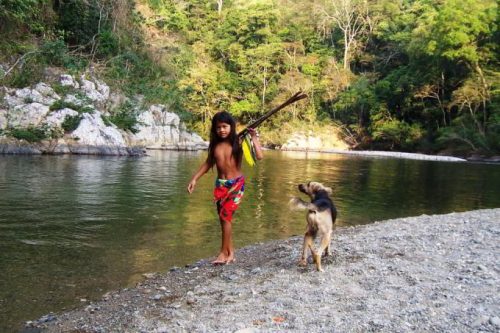The Guarani. The great family of creation.

For indigenous peoples, the earth is like a mother who offers her children the best that she herself can produce. Women are the producers and guardians of the common home.
At Guarani ceremonies in Paraguay, shamans perform prayers in the form of a sacred dance to the rhythm of the beating (with the tacuara) of the women on the ground. One of its meanings is that women, as the creators and guardians of life, perceive a whole microcosm of life sleeping beneath the earth: seeds, germs and embryos of different species, specific to each country.
With their beating, the women want to awaken this hidden life and invite it to become part of the rhythm of praise and gratitude towards the creator of the land. This vision takes us back to the sources of life and fills us with sacredness, as expressed by Pope Francis in the encyclical ‘Querida Amazonia’: “We should esteem the indigenous mysticism that sees the interconnection and interdependence of the whole of creation, the mysticism of gratuitousness that loves life as a gift, the mysticism of a sacred wonder before nature and all its forms of life. ” (Q.A. 73).

Indigenous women say that each territory has its own life plan, which they must investigate and learn about to collaborate with it. File swm
This way of celebrating by the indigenous people was born from a profound coexistence with their territory which opened up to them the mystery of life as sacred ground. In fact, they explain it: “With our vision we affirm our otherness to this modern system from our millenary way of occupying the land. It is the commitment of our life that follows thousands of other lives in past, present and future times and is inscribed in fulfilling our spiritual duty to safeguard our sacred lands.”
Indigenous people have different images of their territory. For example, the Guaraní see their territory as a woman in whose veins their blood flows, represented by the water of the rivers and streams that exudes life with exuberance, fertilizing the land and producing fruit. The earth, in the vision of almost all indigenous peoples, is like a Mother who offers her children the best that she herself can produce.

The ancestors have already discovered that their territory is the “integrating centre of community life”. File swm
For them, the earth has a life of its own and can therefore also die. From gratitude for this maternal care, comes the desire to take care of it in reciprocity, out of filial affection. This principle of reciprocity is inherent in every territory and in every people, it is the basis of every form of coexistence. Some indigenous women say that each territory has its own life plan, which they must investigate and learn about to collaborate with it. This mother-child reciprocity must be constantly renewed in every family home, but always within the horizon of the universal common home, the great family of creation.
Women, experts in being generators and custodians of life, know the specific properties of their territory: diversity, fragility, etc. and try to organize meetings to exchange their experiences and develop a holistic vision. Their goal is to maintain, restore, rebuild and renew the harmony and balance in their coexistence with the territory. As a community, they plan planting, growing, harvesting and distribution and invent ways to cook and preserve all the edible food their territory offers. They invent typical foods with the flavours of the territory.

Women have always passed on their customs, customary rights and traditions to the new generations. File swm
They also know how to organize themselves with a clear and courageous choice to defend the rights and dignity of life in coexistence with their own territory and for socio-environmental justice among all the cultures present. They know how to collaborate with the rhythm of nature, enter its renewal cycles and adapt to historical and climatic changes. At the same time, they know how to take care of their own memory, reconnecting to the origins and utopias of the past. This looking to the past leads them to look to the future, which gives them the audacity to transform anachronistic structures that are no longer viable.
These organized women know how to take their gaze from the “edge of the food plate” of every day, and broaden it to a universal gaze, a utopia, which leads to the door of the Common Home, always ajar to relieve the overload of conflicts, fatigue, problems and daily difficulties, erasing that “languid gaze”. Thanks to their sense of community, their spirit of collective resistance and their tender affection for their land, these women remain steadfast and united and thus overcome difficult situations with collective hope. Since the life of the territory is sacred, women tend to protect the most fragile and weak forms of life at a socio-environmental level. They know how to prevent heat and cold, drought and floods, the danger of parasites and agrotoxins, etc., always defending, caring for and rebuilding harmony and balance in the coexistence of the territory. Their ancestors have already discovered that their territory is the “integrating centre of community life”.
To maintain the intimate relationship between the human community and territory, it is necessary to have a common dream, a utopia. There are various names for this dream, such as Land without Evil,
Good Living, Common Home …

To maintain the intimate relationship between the human community and territory, it is necessary to have a common dream, a utopia. File swm
For indigenous women, caring for the Common Home always begins with caring for one’s home in the territory. In some ancient myths of the Gran Chaco and the Guaraní aquifer, women appear as collaborators in creation. Climatic, ecological, topographical conditions, etc. inspired their creative intuitions in developing, together, over the generations, their own cosmovision, their own language, their own organizational structures, etc. They have always passed on their customs, customary rights and traditions to the new generations as faithful guardians of the culture of their territory because these women know how to combine affection for their territory with that for their community/people, which makes them discover the intertwined dream of the common home. They know how to listen to the cries of the wounded and beaten from the open veins of their territory and they know how to distinguish among them the groans of the birth of a new creation (Rom 8:22). (Open Photo: Pixabay)
Margot Bremer



